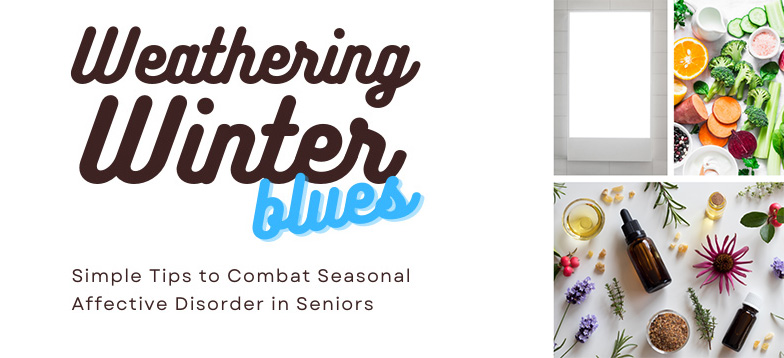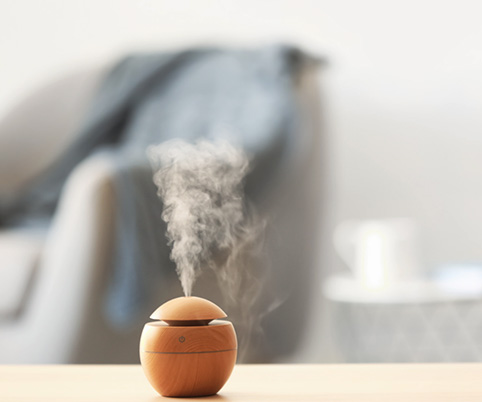Simple Tips to Combat Seasonal Affective Disorder in Seniors

Feeling blue in the middle of winter isn’t just because it’s cold and dark outside most of the time.
There’s a medically-recognized condition that explains why you might not feel like getting out of bed in the morning, or why you’re craving sweets and breads instead of healthier foods.
It’s Seasonal Affective Disorder, and it affects more than 10 million Americans each year.
Norman E. Rosenthal, MD, a Clinical Professor of Psychiatry at Georgetown University Medical School and Medical Director of the Capital Clinical Research Associates, says,“Every year, as the days become short and dark, people with SAD develop a predictable set of symptoms. They slow down and have a hard time waking up in the morning. Their energy level decreases, they tend to eat more, especially sweets and starches, and they gain weight. Their concentration suffers, and they withdraw from friends and family.”
Elders who experience seasonal changes in mood can have more intense symptoms due to isolation from loved ones, less mobility and even cognitive deficits.

Common Signs of Seasonal Affective Disorder (SAD)
According to Mayo Clinic, SAD might go away as the seasons change, but they are serious. Here are some common symptoms from Mayo:
- Feeling listless, sad or down most of the day, nearly every day
- Losing interest in activities you once enjoyed
- Having low energy and feeling sluggish
- Having problems with sleeping too much
- Experiencing carbohydrate cravings, overeating and weight gain
- Having difficulty concentrating
- Feeling hopeless, worthless or guilty
- Having thoughts of not wanting to live
What to do about it
Sometimes it’s just not feasible or safe to go for that walk outside because it’s too cold or the ground is too slippery with ice. Or the weather is so treacherous that traveling in a car or bus to a gym facility is just a bad idea.
At the same time, the weather can be such a bummer, it’s just hard to want to be very active in the first place. While it’s definitely OK to reduce physical activity at times, exercise is one of the best ways to beat the winter blues.
So while you may have some symptoms of SAD, keep exercise on the top of your list to help kick symptoms to the curb. Meantime, here are some other, simple ways to prevent or reduce SAD if it’s affecting you or someone you love.
IMPORTANT: Talk with your health care team before introducing new supplements, foods or activities into your daily wellness routine.

Tip #1: Up your Vitamin D
Also known as the sunshine vitamin, vitamin D is both a nutrient we digest and a hormone our bodies make naturally. Vitamin D improves bone health, energy and mood, and also prevents a slew of diseases.
People who live in northern climates are often deficient in this vitamin, especially during the winter when there’s more dark hours than daytime.
Unfortunately, the best way to get vitamin D is through sun exposure. The next best way is through supplements you can buy from a trusted nutrition source, like Swanson Health.
If you’d like to try and get more vitamin D through the foods you eat, here are your best bets:
- Cod liver oil
- Salmon
- Swordfish
- Tuna fish
- Sardines
- Beef liver
- Egg yolk
- Fortified milk, orange juice and cereals

Tip #2: Set up light box therapy devices
Because people who live in northern climates lack adequate sunshine in winter, many health care practitioners recommend supplementing natural light with light therapy in the form of light boxes.
Also known as phototherapy, light box therapy is also a common practice in many office environments these days where employees also don’t get enough sunshine to cheer them up.
Tip #3: Try diffusing essential oils
Essential oils are highly concentrated tinctures made from flowers, fruit, wood, grasses and other elements found in nature. Cultures across the world have used essential oils for thousands of years to help treat common ailments, from earaches to anxiety.
Today, essential oils are enormously popular and come in a variety of pre-formulated blends based on need. They smell amazing and have many healing benefits, as well.
To help boost your mood, try adding citrus scents, like lemon and orange, to an essential oil diffuser. Use the diffuser in rooms where you spend a lot of time and enjoy the pleasant scents that can restore your sense of well-being on those down days of winter.
Oils that are great for winter months:
- Lavender oil
- Citrus oils (bergamot, lemongrass, sweet orange, grapefruit)
- Cedarwood
- Peppermint
- Frankincense

Tip #4: Socialize
Much like getting exercise feels like a difficult task you don’t want to do, especially when you’re feeling down, socializing is one of those activities that has a way of boosting your mood (even when you’d rather stay in bed where it’s warm).
Simple ways to socialize that can help SAD symptoms:
- Set a 15-minute phone date with a friend or loved one
- Chat on Facebook Messenger with a friend
- Make a pie and coffee date with a neighbor
- Write or type a letter to a friend
- Sign up for a yoga class
- Play Scrabble after dinner
Tip #5: Ask for help
Perhaps the most important (and most difficult) tip on the list is to seek help if you’re feeling super down. There are prescription medications that can help alleviate the clinical symptoms of SAD, including certain antidepressants. Talk with a trusted loved one, friend or health care team member about how you’re feeling.
Moods come and go, of course. But when bad feelings stick around longer than you’d like, it’s time to take action. Not only will you improve your day-to-day wellness, but you’re taking action for better long-term health as you strive to grow bolder in these amazing later decades of your life.
Be well and healthy!